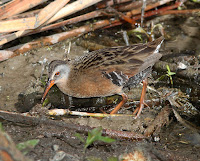VIRGINIA RAIL
VIRGINIA RAIL – (Rallus limicola) – (See images below)
DESCRIPTION: The Virginia Rail has a mostly brown plump body with dark streaks on the back. Sides and breast are rufous. Rump is black with fine white bars. Cheeks are grey, eyes and bill reddish-brown, and legs dark orange. Bill is long, thin and slightly curved downward. Toes are long. Tail is very short. Sexes are similar. Chicks are black. Bird length at around 25 cm (10 inches).
VOICE: https://www.xeno-canto.org/species/Rallus-limicola
NAME: English name ‘Rail’, (and genus name ‘Rallus’) derives from old French and means ‘to make a scraping noise’, in reference to the bird calls. ‘Virginia’ would relate to the location where the first individual was identified. Latin species name ‘limicola’ means ‘mud’, in reference to the bird’s habitat.
HABITAT: Freshwater inland wetlands such as marshes, bogs.
DIET: Digs into the water or mud with its specialized bill for aquatic insects or crustaceans. Also preys on small fish or amphibians.
NESTING: Nest built on emergent vegetation in a marsh, hidden with a canopy of vegetation. Dummy nests also added around the marsh. From four to a dozen light beige eggs are laid, incubated by both parents. Chicks fed by both parents.
DISTRIBUTION: Breeding range covers the southern part of Canada and the northern part of the USA. Migrates to the southern USA and Central America for the winter.
Distribution map: https://en.wikipedia.org/wiki/Virginia_rail#/media/File:Rallus_limicola_map.svg
ON PEI: Breeds on Prince Edward Island, but occurrence rare or uncommon.
CONSERVATION: Population trends difficult to evaluate due to difficulty of habitat observation. Thought to be widespread and common, however vulnerable to loss of habitat due to wetland drainage for agriculture and urban development.
NOTES: The Virginia rail is a small water bird part of a family that includes coots and gallinules. This bird can also swim and dive, but will run away rather than fly in case of danger. The long toes help it walk on floating vegetation. Often cohabits with the Sora, but the two species have different diets.
SIMILAR SPECIES: King Rail
REFERENCES: https://www.borealbirds.org/bird/virginia-rail
https://www.mba-aom.ca/jsp/toc.jsp (Maritimes Breeding Bird Atlas)
https://www.audubon.org/field-guide/bird/virginia-rail
https://en.wikipedia.org/wiki/Virginia_rail
https://nature.mdc.mo.gov/discover-nature/field-guide/virginia-rail (Missouri Department of Conservation)
http://fieldguide.mt.gov/speciesDetail.aspx?elcode=ABNME05030 (Montana Field Guide)
http://identify.whatbird.com/obj/514/overview/Virginia_Rail.aspx
https://animaldiversity.org/accounts/Rallus_limicola/ (University of Michigan)
https://www.allaboutbirds.org/guide/Virginia_Rail/id
DESCRIPTION: The Virginia Rail has a mostly brown plump body with dark streaks on the back. Sides and breast are rufous. Rump is black with fine white bars. Cheeks are grey, eyes and bill reddish-brown, and legs dark orange. Bill is long, thin and slightly curved downward. Toes are long. Tail is very short. Sexes are similar. Chicks are black. Bird length at around 25 cm (10 inches).
VOICE: https://www.xeno-canto.org/species/Rallus-limicola
NAME: English name ‘Rail’, (and genus name ‘Rallus’) derives from old French and means ‘to make a scraping noise’, in reference to the bird calls. ‘Virginia’ would relate to the location where the first individual was identified. Latin species name ‘limicola’ means ‘mud’, in reference to the bird’s habitat.
HABITAT: Freshwater inland wetlands such as marshes, bogs.
DIET: Digs into the water or mud with its specialized bill for aquatic insects or crustaceans. Also preys on small fish or amphibians.
NESTING: Nest built on emergent vegetation in a marsh, hidden with a canopy of vegetation. Dummy nests also added around the marsh. From four to a dozen light beige eggs are laid, incubated by both parents. Chicks fed by both parents.
DISTRIBUTION: Breeding range covers the southern part of Canada and the northern part of the USA. Migrates to the southern USA and Central America for the winter.
Distribution map: https://en.wikipedia.org/wiki/Virginia_rail#/media/File:Rallus_limicola_map.svg
ON PEI: Breeds on Prince Edward Island, but occurrence rare or uncommon.
CONSERVATION: Population trends difficult to evaluate due to difficulty of habitat observation. Thought to be widespread and common, however vulnerable to loss of habitat due to wetland drainage for agriculture and urban development.
NOTES: The Virginia rail is a small water bird part of a family that includes coots and gallinules. This bird can also swim and dive, but will run away rather than fly in case of danger. The long toes help it walk on floating vegetation. Often cohabits with the Sora, but the two species have different diets.
SIMILAR SPECIES: King Rail
REFERENCES: https://www.borealbirds.org/bird/virginia-rail
https://www.mba-aom.ca/jsp/toc.jsp (Maritimes Breeding Bird Atlas)
https://www.audubon.org/field-guide/bird/virginia-rail
https://en.wikipedia.org/wiki/Virginia_rail
https://nature.mdc.mo.gov/discover-nature/field-guide/virginia-rail (Missouri Department of Conservation)
http://fieldguide.mt.gov/speciesDetail.aspx?elcode=ABNME05030 (Montana Field Guide)
http://identify.whatbird.com/obj/514/overview/Virginia_Rail.aspx
https://animaldiversity.org/accounts/Rallus_limicola/ (University of Michigan)
https://www.allaboutbirds.org/guide/Virginia_Rail/id
 |
| Virginia rail, CA, by Mike Baird |
 |
| Virginia rail, AZ, by Alan Schmierer |
 |
| Virginia rail newborn chick, USFWS MA |